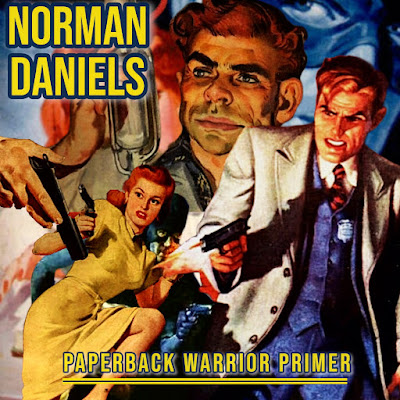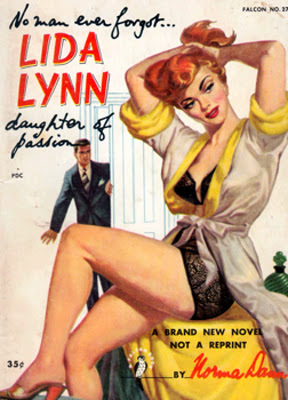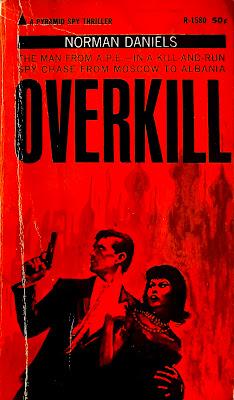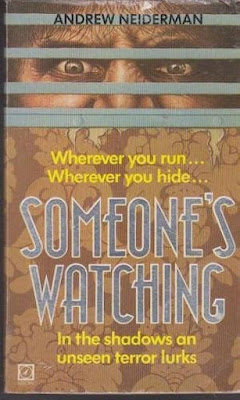Back in 2022, Tom Simon, an alumni of Paperback Warrior, was asked to write an introduction for the Stark House Press twofer A Ticket to Hell and Hell Can Wait, both by the iconic crime-noir writer Harry Whittington. I wanted to share this write-up with the Paperback Warrior fans and readers that didn't have the opportunity to purchase the book. I hope you enjoy it. "Investigating Harry"
“Have you ever heard of an author named Harry Whittington?” I asked the used bookstore lady.
I was in Ocala, Florida trying to dig up information that might be helpful for the introduction to this Harry Whittington twofer. Smarter guys than me have written introductions for previous Harry Whittington reprints. I needed an angle, so I was sniffing around Harry’s childhood hometown looking for leads.
I should probably explain that I’m a recently-retired FBI Special Agent who spent the last five years of the job investigating federal crimes in Northern Florida. I worked a handful of cases in Ocala, but this was my first time back since I retired and opened my own private eye firm. However, it wasn’t my sleuthing that landed me this writing gig. Stark House hit me up because of my side-hustle, a blog and podcast called Paperback Warrior where I cover pulp fiction with my buddy Eric. We host the largest collection of Harry Whittington book reviews on the internet, so Stark House figured I might have something to say about Harry’s work that hadn’t already been said - a tall order.
Facing the problem of what to write that hadn’t already been covered, I recalled a saying: “When all you have is a hammer, every problem looks like a nail.” I’m an investigator, so I drove down to Ocala to knock on some doors.
A Ticket to Hell was the first of Harry’s books I read and remains my favorite. I reviewed Hell Can Wait much later and enjoyed it quite a bit. I could go on and on about the stuff I liked about each paperback, but I don’t want to spoil either novel for you. I hate it when introductions do that, and I don’t want to be that guy. You should read both, and I promise you’ll like them. If you only have one week to live and must choose, go with A Ticket to Hell. It’s the stronger of the pair.Ocala is pretty far inland, so erase from your mind images of the sandy beaches of Miami or Daytona. This is non-coastal Florida marshland. Harry clearly drew upon this lush and humid ecosystem for many of his swamp-noir novels - Cracker Girl, Swamp Kill, Backwoods Hussy, and Backwoods Shack among them. If that sub-genre is your jam, the best is Backwoods Tramp, also released as A Moment To Prey. Driving through the sand pines and magnolia trees of the Ocala National Forest, I understood why this setting was so alluring for many of Harry’s early paperbacks. It’s a vivid and earthy place thick with Spanish moss dripping from the branches - a perfect setting for a rural noir tale.
When Harry was growing up, Ocala was a one-horse town. Nowadays, there are thousands of horses. In fact, breeding and training horses is Ocala’s main industry. The city leaders call it “The Horse Capital of the World,” and Marion County hosts more than 600 thoroughbred farms. Back in Harry’s day, Ocala farmers were mostly raising citrus, cotton and tobacco.
Fun Fact: The town’s only real celebrity today is John Travolta, who owns a giant compound in a subdivision with its own airfield. I wanted to ask him if he’s heard of Harry Whittington, so I drove out to his gated neighborhood to snoop. I made it through a haphazardly-opened gate and toured for about ten minutes marveling at the mansions - each with their own airplane hanger. There was no sign of Mr. Travolta when I was pulled over by neighborhood security and swiftly shown the exit gate.I continued my field investigation at Ocala’s best used bookstore. There are only two remaining, and the other one is a lousy firetrap. The good one is called A Novel Idea, and it’s in a strip mall near a movie theater. I always made it a point to swing by the place whenever I was working a case in the area. I had long since bought all their vintage crime paperbacks, but I still liked visiting - mostly to see the store’s two in-house cats: Lord Byron and F. Scott Fitzgerald. In my absence, Fitzy had died. Now there’s only Lord Byron on the lookout for paperback shoplifters.
The store’s proprietor is Lori. Her daughter is the owner, but Lori runs the joint. She’s from Ocala but admitted that she’d never heard of Harry Whittington.
“He was born and raised here as a kid,” I told her. “He later moved to St. Petersburg and authored over 170 novels during the mid-20th century. They called him The King of Paperbacks because he was so prolific. He wrote books in a bunch of different genres under his own name and a giant list of pseudonyms.”
She listened politely to my Wikipedia speech and acted about as interested as retail politeness would dictate. Honestly, I wasn’t sure what I was expecting. Excitement? Tears? A discount?I swung by the public library in Ocala and asked the same question with similar results. The lady at the information desk had never heard of Harry, and the library carried none of his books. I hadn’t struck out this much with women since I was dating. Small towns are supposed to lionize their native sons, but Harry had been seemingly wiped from everyone’s memory here.
I needed an informant with good intel, so I contacted the Marion County Genealogical Society and asked them to do some digging. A fellow named Arnold Davis turned up some good dirt using historical records.
Harry’s parents (Harry Sr. & Rosa Hardee) were married on June 12, 1912 at the home of Rosa’s parents on South Magnolia Street. The happy couple settled into a house on Pond Street, and Harry was born on February 4, 1915. His dad ran Staple & Fancy Groceries on Main Street, and the family was somewhat wealthy compared to the farmers residing in the area.
Arnold the Informant uncovered a mosaic of family stories from Harry’s childhood - family trips to the beach in Daytona and a wayward nail that almost blinded his mom. One foggy night in 1922, Harry Sr. crashed his truck into a “dummy cop” statue erected in the middle of Main Street. The city had strategically placed these dummies to slow traffic, and the accident resulted in a lofty fine of $11.10 to cover repairs to the inert lawman.
I went by the locations of Harry’s three childhood homes in Ocala. I was pleased to find that there were many places in the Historical District remaining from Harry’s era, but none of his houses remained. I had lunch at an old fashioned diner that used to be Elliott’s Drive-In back in the day. The food was excellent, but the waitress never heard of Harry.
After World War I in 1918, Ocala was a hot spot for tourists from the north visiting by way of the Orange Blossom Trail, now Highway 27. This was before the development of America’s interstate highway system, and Model-T tourism sparked the golden age of roadside attractions. Ocala’s contribution to this culture was Silver Springs. It’s now a state park, and I paid two bucks to walk through the paths surrounding the waters. Signs warned me to beware of both alligators and monkeys (feed neither, please). When Harry was 14, a guy named Ross Allen used to wrestle alligators there to the delight of both locals and tourists. From 1958 to 1961, Lloyd Bridges filmed the underwater adventure scenes for Sea Hunt in the spring’s crystal clear waters.
I hit up my friend Ben Boulden. He’s a great author living in Utah and a solid guy. I remembered his introduction to a Stark House double by Lionel White and how much I enjoyed it. Ben is a whiz at researching old census records, so I solicited his help.
Ben hooked me up with a good timeline of Harry’s life using census and other historical records that I overlaid with the intel from Arnold to create a coherent timeline. Sometime around 1924, the Whittington clan moved 100 miles away to Tampa on the Gulf of Mexico, and Harry’s dad landed a job as a salesman for C.B. Witt Company, a wholesale grocer. For unclear reasons, Harry returned to Ocala in September 1930 as a transfer student from St. Petersburg to complete his final two years of high school. I’m guessing he lived with grandparents or extended family until he graduated from Ocala High School on June 3, 1932.
I wanted to head over to Harry’s alma mater to regale the students vaping in the parking lot with stories about “The King of Paperbacks.” It became Forest High School in 1969 and is now Marion Technical Institute, a place for kids looking to get into the trades. I went by the school but didn’t see the upside of hassling these future welders, cooks and first responders with dumb questions about a long-dead author.
Harry returned to the family home in St. Petersburg after graduating high school in Ocala. By 1935, Harry’s dad was employed as a driver for Florida Milk Company. I recalled that a milkman was the main character in Like Mink, Like Murder, a Whittington oddity also reprinted by Stark House. For his part, Harry landed a job as a mail carrier for the U.S. Postal Service.On February 6, 1936, 21 year-old Harry married Kathryn Odom, and the couple settled down in Saint Petersburg with Harry continuing his mailman gig until he was drafted in 1940. This military service was followed by a voluntary enlistment in the U.S. Navy from April 1945 to March 1946.
Shortly after his release from the Navy, Harry sold his first novel, a western titled Vengeance Valley. In 1947, he sold a hardcover called Her Sin about a pleasure-loving girl named Iris. Demand for paperback original novels exploded in 1950, and Harry met that demand becoming one of the most prolific writers of paperback potboilers in the world. By 1957, Harry had 50 novels published under his own name and a cadre of pseudonyms. That same year, he was identified as a professional author in a St. Petersburg citizen’s directory uncovered by Informant Ben.

My manhunt concluded at Royal Palm South Cemetery in St. Petersburg where Harry was laid to rest in 1989 - later to be joined by his wife and daughter. His tombstone reads, “Master of the Roman Noir: One Of The Greats Among American Novelists.” An internet search explained that “Roman Noir” is a French term for a mystery or thriller, literally a “Dark Novel.”
Indeed, Harry’s best work was noir fiction, and you are holding in your hands two excellent examples of an American author at the top of his dark novel game. Still, I found his epigraph a bit reductive. Harry excelled at so many different genres: Westerns, Espionage, TV Tie-Ins, Historical Gothics, Erotica, Nursing Dramas and on and on. Some were good and others were not - but the guy’s cross-genre productivity was staggering and unmatched among his peers.
I left his gravesite thinking that even on his own tombstone, Harry didn’t get the credit he deserves. In any case, I’m glad you cared enough about his writing to pick up this Whittington double-shot.
After all, Harry is a guy who deserves to be remembered.


















.jpg)











